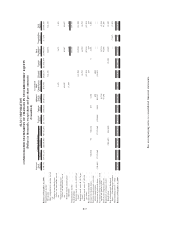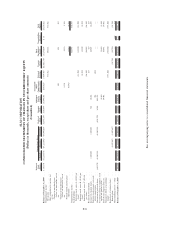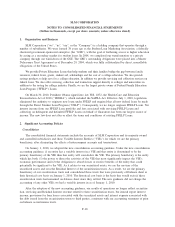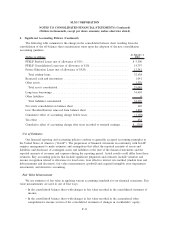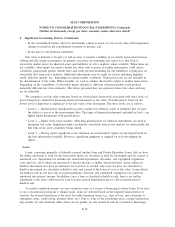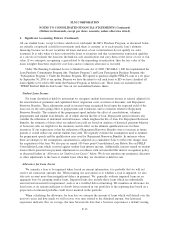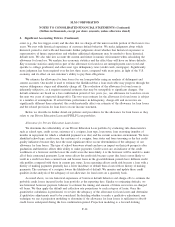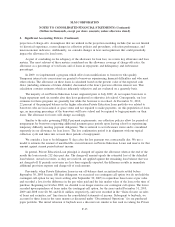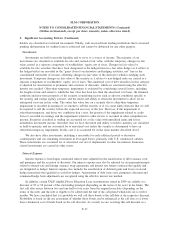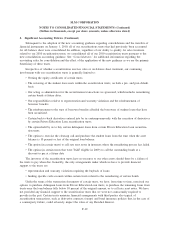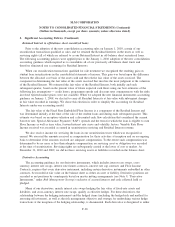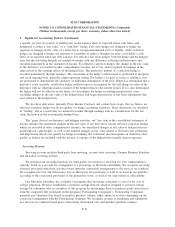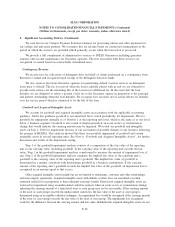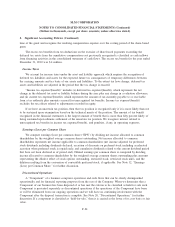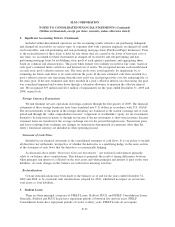Sallie Mae 2010 Annual Report Download - page 120
Download and view the complete annual report
Please find page 120 of the 2010 Sallie Mae annual report below. You can navigate through the pages in the report by either clicking on the pages listed below, or by using the keyword search tool below to find specific information within the annual report.2. Significant Accounting Policies (Continued)
holders are classified as restricted investments. Finally, cash received from lending institutions that is invested
pending disbursement for student loans is restricted and cannot be disbursed for any other purpose.
Investments
Investments are held to provide liquidity and to serve as a source of income. The majority of our
investments are classified as available-for-sale and carried at fair value, with the temporary changes in fair
value carried as a separate component of stockholders’ equity, net of taxes. Changes in fair value for
available-for-sale securities that have been designated as the hedged item in a fair value hedge (as it relates to
the hedged risks) are recorded in the “gains (losses) on derivative and hedging activities, net” line in the
consolidated statements of income, offsetting changes in fair value of the derivative which is hedging such
investment. Temporary changes in fair value of the security as it relates to non-hedged risks are carried as a
separate component of stockholders’ equity, net of taxes. The amortized cost of debt securities in this category
is adjusted for amortization of premiums and accretion of discounts, which are amortized using the effective
interest rate method. Other-than-temporary impairment is evaluated by considering several factors, including
the length of time and extent to which the fair value has been less than the amortized cost basis, the financial
condition and near-term prospects of the security (considering factors such as adverse conditions specific to
the security and ratings agency actions), and the intent and ability to retain the investment to allow for an
anticipated recovery in fair value. The entire fair value loss on a security that is other-than-temporary
impairment is recorded in earnings if we intend to sell the security or if it is more likely than not that we will
be required to sell the security before the expected recovery of the loss. However, if the impairment is
other-than-temporary, and those two conditions don’t exist, the portion of the impairment related to credit
losses is recorded in earnings and the impairment related to other factors is recorded in other comprehensive
income. Securities classified as trading are accounted for at fair value with unrealized gains and losses
included in investment income. Securities that we have the intent and ability to hold to maturity are classified
as held-to-maturity and are accounted for at amortized cost unless the security is determined to have an
other-than-temporary impairment. In this case it is accounted for in the same manner described above.
We also have other investments, including a receivable for cash collateral posted to derivative
counterparties and our remaining investment in leveraged leases, primarily with U.S. commercial airlines.
These investments are accounted for at amortized cost net of impairments in other investments. Insurance-
related investments are carried in other assets.
Interest Expense
Interest expense is based upon contractual interest rates adjusted for the amortization of debt issuance costs
and premiums and the accretion of discounts. Our interest expense may also be adjusted for net payments/receipts
relatedtointerestrateandforeigncurrencyswapagreements and interest rate futures contracts that qualify and
are designated as hedges. Interest expense also includes the amortization of deferred gains and losses on closed
hedge transactions that qualified as cash flow hedges. Amortization of debt issue costs, premiums, discounts and
terminated hedge basis adjustments are recognized using the effective interest rate method.
In addition, certain TALF eligible Private Education Loan securitizations issued in 2009 are callable at a
discount of 93 or 94 percent of the outstanding principal (depending on the terms of the note) in the future. The
first call date occurs between two and one-half to four years from the original issue date (depending on the
terms of the note) and the note is eligible to be called until the end of the call period which lasts six to twelve
months. We have concluded that it is probable we will call these bonds at the call date at the respective discount.
Probability is based on the our assessment of whether these bonds can be refinanced at the call date at or lower
than a breakeven cost of funds based on the call discount. As a result, we are accreting this call discount as a
F-17
SLM CORPORATION
NOTES TO CONSOLIDATED FINANCIAL STATEMENTS (Continued)
(Dollars in thousands, except per share amounts, unless otherwise stated)


